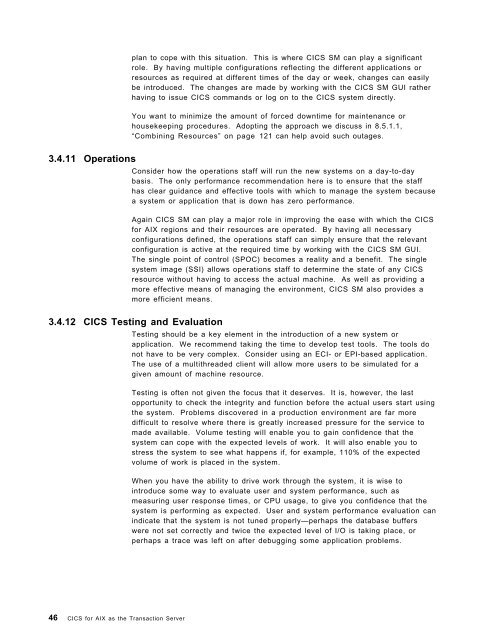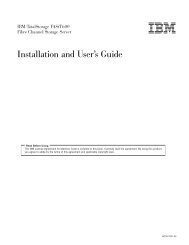Addressing OLTP Solutions with CICS: The Transaction Server ... - Ibm
Addressing OLTP Solutions with CICS: The Transaction Server ... - Ibm
Addressing OLTP Solutions with CICS: The Transaction Server ... - Ibm
You also want an ePaper? Increase the reach of your titles
YUMPU automatically turns print PDFs into web optimized ePapers that Google loves.
3.4.11 Operations<br />
plan to cope <strong>with</strong> this situation. This is where <strong>CICS</strong> SM can play a significant<br />
role. By having multiple configurations reflecting the different applications or<br />
resources as required at different times of the day or week, changes can easily<br />
be introduced. <strong>The</strong> changes are made by working <strong>with</strong> the <strong>CICS</strong> SM GUI rather<br />
having to issue <strong>CICS</strong> commands or log on to the <strong>CICS</strong> system directly.<br />
You want to minimize the amount of forced downtime for maintenance or<br />
housekeeping procedures. Adopting the approach we discuss in 8.5.1.1,<br />
“Combining Resources” on page 121 can help avoid such outages.<br />
Consider how the operations staff will run the new systems on a day-to-day<br />
basis. <strong>The</strong> only performance recommendation here is to ensure that the staff<br />
has clear guidance and effective tools <strong>with</strong> which to manage the system because<br />
a system or application that is down has zero performance.<br />
Again <strong>CICS</strong> SM can play a major role in improving the ease <strong>with</strong> which the <strong>CICS</strong><br />
for AIX regions and their resources are operated. By having all necessary<br />
configurations defined, the operations staff can simply ensure that the relevant<br />
configuration is active at the required time by working <strong>with</strong> the <strong>CICS</strong> SM GUI.<br />
<strong>The</strong> single point of control (SPOC) becomes a reality and a benefit. <strong>The</strong> single<br />
system image (SSI) allows operations staff to determine the state of any <strong>CICS</strong><br />
resource <strong>with</strong>out having to access the actual machine. As well as providing a<br />
more effective means of managing the environment, <strong>CICS</strong> SM also provides a<br />
more efficient means.<br />
3.4.12 <strong>CICS</strong> Testing and Evaluation<br />
46 <strong>CICS</strong> for AIX as the <strong>Transaction</strong> <strong>Server</strong><br />
Testing should be a key element in the introduction of a new system or<br />
application. We recommend taking the time to develop test tools. <strong>The</strong> tools do<br />
not have to be very complex. Consider using an ECI- or EPI-based application.<br />
<strong>The</strong> use of a multithreaded client will allow more users to be simulated for a<br />
given amount of machine resource.<br />
Testing is often not given the focus that it deserves. It is, however, the last<br />
opportunity to check the integrity and function before the actual users start using<br />
the system. Problems discovered in a production environment are far more<br />
difficult to resolve where there is greatly increased pressure for the service to<br />
made available. Volume testing will enable you to gain confidence that the<br />
system can cope <strong>with</strong> the expected levels of work. It will also enable you to<br />
stress the system to see what happens if, for example, 110% of the expected<br />
volume of work is placed in the system.<br />
When you have the ability to drive work through the system, it is wise to<br />
introduce some way to evaluate user and system performance, such as<br />
measuring user response times, or CPU usage, to give you confidence that the<br />
system is performing as expected. User and system performance evaluation can<br />
indicate that the system is not tuned properly—perhaps the database buffers<br />
were not set correctly and twice the expected level of I/O is taking place, or<br />
perhaps a trace was left on after debugging some application problems.
















